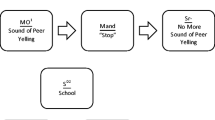Abstract
Research on the functional independence of verbal operants (Skinner, 1957) has demonstrated inconsistent findings. One explanation may be that these studies have not manipulated the motivating operation (MO) to facilitate the emergence of mands (Hall & Sundberg, 1987; Lamarre & Holland, 1985). In the current study, 1 participant, diagnosed with autism, was taught to tact high-preference and low-preference leisure items, and emergence of mands was tested under varying MO conditions. Results showed the emergence of mands following periods of arranged deprivation, and greater maintenance for a highly preferred relative to a less preferred stimulus. However, mands only emerged when presession tact trials were conducted. These results suggest that in a state of deprivation, transfer of stimulus control from discriminative to motivational conditions may occur without direct training.
Similar content being viewed by others
References
Catania, A. C. (1998). Learning: 4th edition. Upper Saddle River, NJ: Prentice Hall.
Egan, C. E., & Barnes-Holmes, D. (2011). Examining antecedent control over emergent mands and tacts in young children. The Psychological Record, 61, 127–140.
Fisher, W., Piazza, C. C., Bowman, L. G., Hagopian, L. P., Owens, J. C., & Slevin, I. (1992). A comparison of two approaches for identifying reinforcers for persons with severe and profound disabilities. Journal of Applied Behavior Analysis, 25, 491–498.
Hall, G., & Sundberg, M. L. (1987). Teaching mands by manipulating conditioned establishing operations. The Analysis of Verbal Behavior, 5, 41–53.
Kelley, M. E., Shillingsburg, M. A., Castro, M. J., Addison, L. R., & LaRue, Jr., R. H. (2007). Further evaluation of emerging speech in children with developmental disabilities: Training of verbal behavior. Journal of Applied Behavior Analysis, 40, 431–445.
Kooistra, E. T., Buchmeier, A. L., & Klatt, K. P. (2012). The effect of motivating operations on the transfer from tacts to mands for children diagnosed with autism. Research in Autism Spectrum Disorders, 6, 109–114.
Lamarre, J., & Holland, J. G. (1985). The functional independence of mands and tacts. Journal of the Experimental Analysis of Behavior, 43, 5–19.
Lerman, D. C., Parten, M., Addison, L. R., Vorndran, C. M., Volkert, V. M., & Kodak, T. (2005). A methodology for assessing the functions of emerging speech in children with developmental disabilities. Journal of Applied Behavior Analysis, 38, 303–316.
Petursdottir, A. I., Carr, J. E., & Michael, J. (2005). Emergence of mands and tacts of novel objects among preschool children. The Analysis of Verbal Behavior, 21, 59–74.
Rosales, R., & Rehfeldt, R. A. (2007). Contriving transitive conditioned establishing operations to establish derived manding in adults with developmental disabilities. Journal of Applied Behavior Analysis, 40, 125–128.
Savage-Rumbaugh, E. S. (1984). Verbal behavior at a procedural level in the chimpanzee. Journal of the Experimental Analysis of Behavior, 41, 223–250.
Sigafoos, J., Doss, S., & Reichle, J. (1989). Developing mand and tact repertoires in people with severe developmental disabilities using graphic symbols. Research in Developmental Disabilities, 10, 183–200.
Skinner, B. F. (1957). Verbal behavior. New York: Appleton-Century-Crofts.
Wallace, M. D., Iwata, B. A., & Hanley, G. P. (2006). Establishment of mands following tact training as a function of reinforcer strength. Journal of Applied Behavior Analysis, 39, 17–24.
Author information
Authors and Affiliations
Corresponding author
Additional information
Kaitlin Coryat is now at the Forbush School at Sheppard Pratt.
This research is based on a project submitted in partial fulfillment of the requirements for the master of arts degree by the first author. We would like to thank John Borrero and Heather Jennett for their comments on previous versions of this manuscript.
Rights and permissions
About this article
Cite this article
Davis, B.J., Kahng, S. & Coryat, K. Manipulating Motivating Operations to Facilitate the Emergence of Mands for a Child With Autism. Analysis Verbal Behav 28, 145–150 (2012). https://doi.org/10.1007/BF03393116
Published:
Issue Date:
DOI: https://doi.org/10.1007/BF03393116




